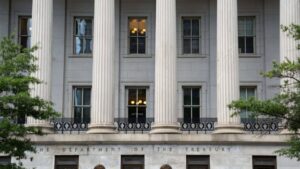Understanding the Surge in the U.S. Deficit: Insights from Extreme Investor Network
As a pivotal month for fiscal matters comes to a close, the financial landscape in the United States reveals some concerning data. As reported by the Treasury Department, the U.S. budget deficit experienced a significant leap in November 2023, raising alarms as we move deeper into fiscal year 2025. At Extreme Investor Network, we dissect these numbers to provide you with insights not only about the causes but also about what it means for investors like you.
The Numbers Explained
In November alone, the budget deficit reached a staggering $366.8 billion, marking a 17% increase compared to November 2022. This spike contributes to an overall deficit for the first two months of the fiscal year that is over 64% higher than the previous year—an alarming trend for policymakers and economists alike. For context, last year’s shortfall exceeded $1.8 trillion, an unsettling benchmark that suggests we are heading into dangerous fiscal territory.
Receipts for November were $301.8 billion, which, despite a year-over-year increase of approximately $27 billion, were overshadowed by a staggering $668.5 billion in outlays. This reflects an almost $80 billion increase in government spending compared to the previous November. The current total national debt has now ballooned to $36.1 trillion, a figure that underscores the scale of the fiscal challenge facing the country.
Deconstructing the Factors Behind the Deficit Surge
Interestingly, the significant increase in the deficit doesn’t solely stem from lower receipts. It also arises from the steadfast growth of government expenditures, particularly net interest expenses. In November, interest expenses hit $79 billion, and for the fiscal year thus far, these expenses have climbed to $160 billion. This outlay now surpasses all others—except for vital services such as Social Security and Medicare—indicating a critical shift in how federal funding is allocated.
The Treasury forecasts that total interest payments on the national debt could soar to $1.2 trillion this year. This trend is particularly noteworthy against the backdrop of recent Federal Reserve actions, which have seen two rate cuts since September totaling 0.75 percentage points. You might wonder why interest expenses remain a heavy burden despite these cuts. The answer lies in the existing debt load and the timing of interest on various debt instruments, leading to protracted expenses irrespective of new monetary policies.
What This Means for Investors
For savvy investors, the implications are profound. The increasing budget deficit could influence everything from government bond yields to stock market volatility. Here are a few key takeaways:
-
Interest Rate Sensitivity: Investors should monitor how rising interest expenses can affect Federal Reserve policy moves. Future interest rate adjustments may be shaped by this burgeoning fiscal reality.
-
Bond Market Dynamics: As deficits swell, the supply of treasury bonds may increase as the government seeks to fill its budget gaps, which could put upward pressure on yields and impact portfolio strategies.
-
Sector Vulnerability: Important sectors such as healthcare, social security, and defense may face budget scrutiny if spending remains unmanageable, prompting investors to consider exposure to these areas cautiously.
- Economic Growth Risks: Sustained deficits can ultimately dampen economic growth, leading to potential repercussions in consumer spending, business investment, and corporate profitability—all factors that investors need to keep in focus.
Final Thoughts
The path ahead appears complex as we grapple with record levels of national debt and increasing fiscal deficits. At Extreme Investor Network, we prioritize providing our readers with actionable insights gleaned from comprehensive analyses of economic trends. Understanding these financial undercurrents will empower our investors to make informed decisions in a landscape that promises to be inherently volatile in the months to come.
Stay connected with us for ongoing updates and expert analysis helping you navigate the ever-changing economic landscape. Your financial future deserves the best information—trust Extreme Investor Network to be your guide.

